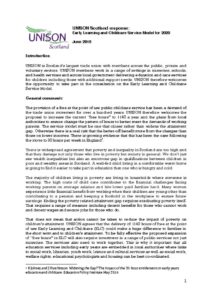 The provision of a free at the point of use public childcare service has been a demand of the trade union movement for over a hundred years. UNISON therefore welcomes the proposal to increase the current free hours to 1140 a year. We also welcome the plans from local authorities to change the pattern of hours to better meet the demands of working parents. The service model must be one that closes rather than widens the attainment gap. Otherwise there is a real risk that the better-off benefit more from the changes than those on lower incomes. There is growing evidence that this has been the case following the move to 30 hours per week in England.
The provision of a free at the point of use public childcare service has been a demand of the trade union movement for over a hundred years. UNISON therefore welcomes the proposal to increase the current free hours to 1140 a year. We also welcome the plans from local authorities to change the pattern of hours to better meet the demands of working parents. The service model must be one that closes rather than widens the attainment gap. Otherwise there is a real risk that the better-off benefit more from the changes than those on lower incomes. There is growing evidence that this has been the case following the move to 30 hours per week in England.
The majority of children living in poverty are living in households where someone is working. The high cost of child care contributes to the financial challenges facing working parents on average salaries and hits lower paid families hard. Many women experience little financial benefit from working when their children are young. All they do is contribute to a pension and keep a foothold in the workplace to ensure future earnings. Ending the poverty related attainment gap requires eradicating poverty itself. That requires a range of measure including decent benefits for those who can’t work and decent wages and secure jobs for those who do.
That does not mean that action cannot be taken to reduce the impact of poverty on children’s attainment. UNISON agrees that the delivery of 1140 hours of free at the point of use Early Learning and Childcare (ELC) could make a huge difference. To be fully effective the proposed expansion of “free hours” in ELC will also require investment in a range of public services not just nurseries. Services also need to work to work together. This is why it important that all education services including early years are embedded in local authorities. This creates strong links to social work, libraries, youth work, leisure and cultural services as well as social work, welfare rights, educational psychologists and housing can be best coordinated.
The evidence is clear that an anti-poverty early learning and childcare service needs to follow a supply side model rather than the “funding follows the child” “provider neutral” model laid out in this consultation. There is a risk that this leads to a system where those who are able to spend more to top up the money from the government will be able to access a higher quality service. There is also a risk they take up a higher proportion of scarce places than those on lower incomes: Widening rather than closing the attainment gap.
Currently there are far too many employers who do not currently pay staff a living wage. While the proposed standard of the real Living Wage will provide a well deserved pay rise for the staff who are currently on the national minimums for their age group it is far too low for qualified childcare workers. The living wage is a calculation based on the bare minimum wages to survive: it is not set to reflect the skills that fully qualified early years staff have. On top of wages staff also need decent pensions, leave, access to flexible working and ongoing professional development. We cannot build a childcare system based on low paid (largely) women workers. This will this lead to a two-tier system where some women will be able to earn high salaries and get subsidised childcare while others earn the bare minimum to survive delivering that childcare.
All the available evidence point to the need for a highly qualified workforce to ensure that children thrive in early learning and childcare centres. The public sector already has far higher rates on qualified staff: it is this sector the government should focus on expanding
